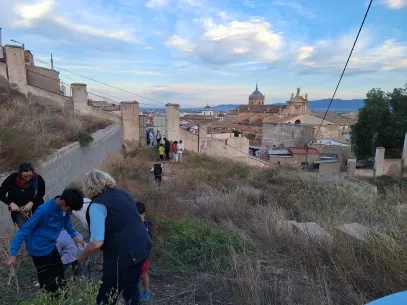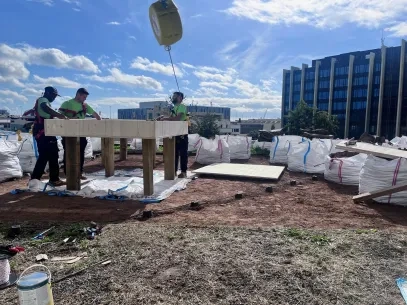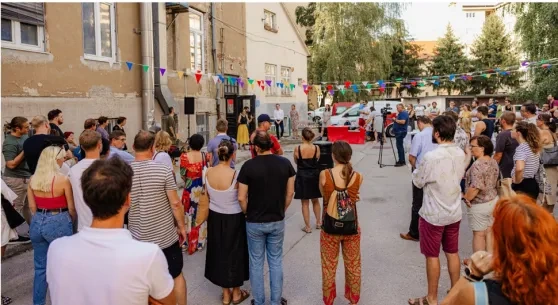UIA has funded 86 urban innovation projects in this programming period. These have been spread across the 14 identified call topics, closely aligned with the priorities of the Urban Agenda for the EU.
Just Transitions was not one of the UIA’s call themes. Consequently, this has not been the focus on the ten case studies presented here. Rather, they have utilised their resources under the banner of Energy Transitions, Climate Change Adaptation, Circular Economy or other topics.
Appendix 1: References
BCNUEJ, 2018. Green Trajectories; Municipal policy trends and strategies for greening in Europe, Canada and United States (1990-2016). URL http://www.bcnuej.org/wp-content/uploads/2018/06/Green-Trajectories.pdf
Beretta, I., Cucca, R., 2019. Ecological gentrification. A European perspective. Introduction. Sociol. URBANA E RURALE.
Center for Climate and Energy Solutions, 2021. Global Emissions. URL https://www.c2es.org/content/international-emissions/ (accessed 12.5.22).
Energy Cities, 2021. Just Transition Working Group Final Report: How to engage energy poor and vulnerable consumers in the energy transition? URL https://ec.europa.eu/energy/sites/default/files/just_transition_working_group_report_final.pdf
EU Energy Poverty Observatory, 2020. Towards an inclusive energy transition in the European Union: Confronting energy poverty amidst a global crisis. URL https://op.europa.eu/o/opportal-service/download-handler?identifier=4a440cf0-b5f5-11ea-bb7a-01aa75ed71a1&format=pdf&language=en&productionSystem=cellar&part=
Eurocities, 2021. Better buildings for climate neutral cities: The ‘Fit for 55’ revision of the Energy Performance of Buildings Directive. URL https://eurocities.eu/wp-content/uploads/2021/09/Eurocities-EPBD_Policy-statement_FINAL.pdf
Eurofound, European Environment Agency, 2021. Exploring the social challenges of low-carbon energy policies in Europe. URL https://www.eea.europa.eu/publications/exploring-the-social-challenges-of
European Commission, 2020. European Commission Pilot Action - Regions in Industrial Transition - Capitalisation Phase : Final Report. URL https://ec.europa.eu/regional_policy/sources/docgener/studies/regions_indust_trans_en.pdf
European Environment Agency, 2022a. Towards ‘just resilience’: leaving no one behind when adapting to climate change. URL https://www.eea.europa.eu/publications/just-resilience-leaving-no-one-behind/towards-just-resilience-leaving-no
European Environment Agency, 2022b. Who benefits from nature in cities? Social inequalities in access to urban green and blue spaces across Europe. URL https://www.eea.europa.eu/publications/who-benefits-from-nature-in
European Environment Agency, 2022c. Economic losses and fatalities from weather- and climate-related events in Europe. URL https://www.eea.europa.eu/publications/economic-losses-and-fatalities-from
European Environment Agency, 2021a. ‘Leaving No One Behind’ in Climate Resilience Policy and Practice in Europe Overview of Knowledge and Practice for Just Resilience. URL https://www.eionet.europa.eu/etcs/etc-cca/products/etc-cca-reports/tp_2-2021/@@download/file/tp_2-2021.pdf
European Environment Agency, 2021b. Renewable energy EU renewable electricity has reduced environmental pressures; targeted actions help further reduce impacts. URL https://www.eea.europa.eu/publications/eu-renewable-electricity-has-reduced
European Environment Agency, 2020. European Union emission inventory report 1990-2018, under the UNECE Convention on Long-range Transboundary Air Pollution (LRTAP). URL https://www.eea.europa.eu/publications/european-union-emission-inventory-report-1990-2018
European Environment Agency, 2018. Unequal exposure and unequal impacts: social vulnerability to air pollution, noise and extreme temperatures in Europe. URL https://www.eea.europa.eu/publications/unequal-exposure-and-unequal-impacts
European Network for Rural Development, 2019. Smart Villages and rural mobility.
European Platform on Sustainable Mobility Plans, 2020. Addressing gender equity and vulnerable groups in SUMPs. URL https://www.eltis.org/sites/default/files/sump_topic-guide_gender-equity_vulnerable-groups_final.pdf
Eurostat, 2021. Can you afford to heat your home? URL https://ec.europa.eu/eurostat/en/web/products-eurostat-news/-/ddn-20210106- 1?redirect=/eurostat/en/news/whats-new
Grossmann, K., 2019. Energy efficiency for whom? A Conceptual view on retrofitting, residential segregation and the housing market. Sociol. URBANA E RURALE.
Housing 2030, 2021. Effective policies for affordable housing in the UNECE region. URL https://unece.org/sites/default/files/2021-10/Housing2030%20study_E_web.pdf
ICLEI, 2022. Equitable Transitions Guidebook: Local tools for fair and inclusive sustainability programs. URL https://circulars.iclei.org/resource/equitable-transitions-guidebook/
IPCC, 2022. Climate Change 2022: Impacts, Adaptation and Vulnerability. URL https://www.ipcc.ch/report/ar6/wg2/downloads/report/IPCC_AR6_WGII_FinalDraft_FullReport.pdf
Janikowska, O., Kulczycka, J., 2021. Just Transition as a Tool for Preventing Energy Poverty among Women in Mining Areas—A Case Study of the Silesia Region, Poland. Energies 14.
Kaltsatou, A., Kenny, G.P., Flouris, A.D., 2018. The Impact of Heat Waves on Mortality among the Elderly: A Mini Systematic Review.
Majdandžić, A., Rodik, D., Eppert, M., 2021. PowerPoor-Baseline Assessment Report, Funded by H2020. URL https://powerpoor.eu/sites/default/files/2021-12/D4.2_Baseline%20A_Report%20V1.0.pdf
OECD, 2018. Rethinking Urban Sprawl: Moving Towards Sustainable Cities. URL https://www.oecd.org/environment/tools-evaluation/Policy-Highlights-Rethinking-Urban-Sprawl.pdf
Osberghaus, D., 2021. Poorly adapted but nothing to lose? A study on the flood risk – income relationship with a focus on low-income households. URL https://www.sciencedirect.com/science/article/pii/S2212096320300589
Polko, P., Kimic, K., 2022. Gender as a factor differentiating the perceptions of safety in urban parks. Ain Shams Eng. J. Vol 13 Issue 3. URL https://www.sciencedirect.com/science/article/pii/S2090447921003737
Ritzen, M., van Oorschot, J., Cammans, M., Segers, M., Wieland, T., Scheer, P., Creugers, B., Abujidi, N., 2019. Circular (de)construction in the Superlocal project.
Simon, D. (Ed.), 2016. Rethinking sustainable cities: Accessible, green and fair. Policy Press. https://doi.org/10.26530/OAPEN_613676
UAP on Climate Adaptation, 2018. Climate Adaptation Partnership Action Plan. URL https://futurium.ec.europa.eu/system/files/migration_files/final_action_plan_last_version.pdf
UNDP, 2018. What does it mean to leave no one behind? A UNDP discussion paper and framework for implementation. URL https://www.undp.org/sites/g/files/zskgke326/files/publications/Discussion_Paper_LNOB_EN_lres.pdf
United Nations, 2021. Sustainable transport, sustainable development: Interagency report - second global sustainable transport conference.
United Nations Foundation, 2016. Common Questions on the Sustainable Development Goals: What Does “No One Left Behind” Mean?
UrbanA, 2020a. Lack of effective knowledge brokerage and stewardship opportunities, Funded by H2020. URL https://wiki.sustainablejustcities.eu/Lack_of_effective_knowledge_brokerage_and_stewardship_opportunities
UrbanA, 2020b. Racialized or ethnically exclusionary urbanization, Funded by H2020. URL https://wiki.sustainablejustcities.eu/Racialized_or_ethnically_exclusionary_urbanization
UrbanA, 2020c. Exclusive access to the benefits of sustainability infrastructure, Funded by H2020. URL https://wiki.sustainablejustcities.eu/Exclusive_access_to_the_benefits_of_sustainability_infrastructure
UrbanA, 2020d. Unquestioned Neoliberal growth and austerity urbanism.
UrbanA, 2020e. Uneven environmental health and pollution patterns.
Vandentorren, S., Bretin, P., Zeghnoun, A., Mandereau-Bruno, L., Croisier, A., Cochet, C., Ribéron, J., Siberan, I., Declercq, B., Ledrans, M., 2006. August 2003 heat wave in France: risk factors for death of elderly people living at home. Eur. J. Public Health 16, 583–591.
Appendix 2: What barriers do cities face in ensuring their transitions are accessible and affordable to all?
Even if the need for cities to further support their transition and to make it affordable and accessible to all is now clear, they are facing major barriers and challenges. As a background, this research analysed key barriers identified by cities, through interviews as well as during an event organised by UIA on 27 and 28 April 2022 in Seville, Spain, on “EU cities acting for just transitions and climate adaptation”. The 15 individual barriers are divided in three categories: Barriers faced by cities, by residents and other barriers. The definitions are given in Table 6 below.
Barriers encountered by cities
Disclaimer: many of these barriers refer to difficulties encountered by municipalities for a range of local issues and local policies, especially in sustainable integrated development, beyond Just Green Transitions. They have been studied at length elsewhere. Here, this work focuses on the specificities of Affordable and Accessible Green Transitions, and the relevance of these barriers under this topic.
Table 6: Barriers' definitions
|
Barriers encountered by cities |
|
|
Lack of strong vision / leadership
|
The climate emergency and the need for Green Transitions is high on the agenda for almost all cities, which acknowledge their role in delivering solutions. Yet, not all elected representatives share this inclusive vision; the complexity of the issues & challenge as well as a lack of knowledge can partially explain this. For example, sustainable energy policies need to consider that the needs and barriers of individuals in energy poverty are peculiar and cannot be addressed with the traditional approaches to the sustainable energy transition: leaders should be aware of the need for new methods. |
|
Lack of policy / delivery system
|
Cities share the concern about inclusivity in the Green Transition. Yet too often there is a lack of strategy or a local plan which clearly include this goal. Any such plan would need to be aligned and/or complementary to regional and/or national frameworks. Therefore, no action is being taken. For example, action to ensure that everybody can access nature-based solutions to address climate adaptation, requires policies targeted at specific neighbourhoods (e.g., with limited green space) and/or specific vulnerable groups. |
|
Lack of data and knowledge on vulnerable groups and their main issues |
Too often, municipalities do not fully grasp the issues at stake or the current situation, the neighbourhood concerned, the people concerned, the implications for the neighbourhoods and their residents, the short and long-term effects on society and the climate. For example, women use public transport more and in a different way to men, which prevents them from making the most of existing services. However, few cities have gender breakdowns on service use and better data is needed. |
|
Lack of an enabling funding framework
|
In some instances, cities seek to implement innovative & inclusive solutions to support the green transition but are hindered by the existing financial framework (budget, spending rules and/or procurement rules) Some cities need to learn how to navigate and make the most of policies or legal opportunities to intervene. For example, procurement rules can make it difficult to bring the most relevant renovation company into a social housing initiative. |
|
Lack of municipal funds |
Surprisingly, in the survey in Seville, only a quarter of the respondents mentioned funding as an issue for implementing solutions. Yet, it is clear that municipalities face competing objectives and priorities as well as limited and declining budgets to deliver policies. For example, economic priorities might be prioritised over sustainability, which could be in turn be prioritised over sustainable actions for vulnerable groups. |
|
Lack of cross-departmentalism |
Public administration often works in silos, making a holistic view or holistic delivery of local suitably tailored and joined-up solutions very difficult.
|
|
Lack of monitoring & evaluation of the policies & actions
|
Municipalities also often lack a monitoring framework that ensures iterative evaluation and improvement of solutions against clearly identified objectives. For example, a public transport strategy designed without follow-up monitoring of the types of people who use it (women, disabled, etc), in which areas (urban-peri-urban), the time of use, frequency of use, prevents the service from being improved and in tune changing needs.
|
|
A civil servant skills deficit |
Readjusting the ways municipalities work requires project management skills, but also skills in design thinking, risk management, participative methods, & social innovation. Such skills are often missing. For example, involving vulnerable groups in the design of green solutions and addressing their needs require co-creation skills. |
|
Difficulty with reaching out to vulnerable groups |
For some cities, it is difficult to identify vulnerable groups or communicate with them, in a way that is meaningful to them. There might also be a lack of ‘bridges’ or ‘intermediaries’ (e.g., NGOs, mediators, translators, etc.) to reach out to them. For example, in terms of energy poverty, migrants are often off the radar and there are barriers (language, culture, trust, knowledge, …) that limit their ability to benefit from public support.
|
|
Barriers encountered by residents |
|
|
Lack of knowledge of the offer by the vulnerable people |
Information on the proposed solutions is not always known to all the potential beneficiaries, communication channels are not relevant and/or the information not understandable in a clear and meaningful way, relevant to the needs of the specific groups. For example, renovation funds might not be widely communicated and might require individuals to look for the information, which does not come directly to them, even if in need. |
|
Lack of adequate provision for vulnerable people |
If solutions fail to account for the realities and needs of the target groups, the latter will have no interest in seeking to access them. For example, captive owners are specific types of low-income people, who, although they own their homes, cannot afford to renovate them and face increasing threats of energy poverty. They have specific characteristics, including specific financial, cultural, or social difficulties with engaging in renovation work and they require targeted actions. |
|
Vulnerable people’s inability to seize opportunities |
Many solutions/services require residents to have some skills, resources, and the time/availability to understand them and/or to access/use them. For example, increasing the use of alternative means of transport requires being able to use them, e.g., the ability to ride a bicycle, which, surprisingly, not everyone knows how to do.
|
|
Lack of personal funds |
Too many solutions still require large personal investments even if the return in the long run is beneficial to the residents. Many cannot afford it. At the same time, there can be a lack of financial incentives that would also help individuals who would like to upgrade the energy performance of their homes. For example, homeowners also have other financial priorities preventing them from embarking on home renovation.
|
|
Other Barriers |
|
|
Wicked socio-economic context
|
The proposed solutions are part of a wider socio-economic context to which they need to be tailored. For example, many cities interested in the green transition, seek to transition from a carbon-intensive manufacturing industry to a green, digital, and high-value industry that can generate sustainable and high-quality jobs. It’s a colossal challenge and many cities lack the resources to influence the mechanisms in play. |
|
Pre-existing urban planning context |
Many cities were built under past construction, mobility, and urban planning standards, which do not comply with current standards of sustainability. For example, housing stock built in the 1960-70s are often low quality and in need of total refurbishment. |
|
Intrinsic technological challenges |
Many of the solutions needed for green transitions are innovative and not yet mature. They face different inherent challenges that still need to be addressed. For example, technologies for blue and green roofs have required numerous adjustments in recent years. |
Appendix 3: Key Witnesses
Table 7: Key Witnesses
|
Key witness |
Organisation |
Topic |
|
Anja de Cunto |
Eurocities - Big Buyers |
Public Procurement |
|
Richard Harding |
Co-author of a JRC Study on Smart Specialisation |
Smart Specialisation |
|
Elena Donnari Teresa Aristegui |
DG ENER - Renovation Wave |
Energy poverty |
|
Brooke Flanagan |
Eurocities - Net Zero Cities |
Energy |
|
Eugenia Mansutti Anna Iafisco |
Eurocities—Covenant of Mayors + Social Affairs |
Climate Energy Housing |
|
Karel Vanderpoorten |
DG GRWO - Affordable Housing Initiative |
Housing |
|
Michaela Kauer |
UAP on Housing (City of Vienna) |
Housing |
|
Dara Trunbull Joao Goncalves |
Housing Europe |
Housing |
|
Piotr Rapacz Madeleine Kelley |
DG MOVE |
Mobility |
|
Peter Saelens |
Eurocities |
Mobility |
|
Ivone Pereira |
European Environment Agency |
Climate Adaptation |
Appendix 4: Sounding Board Members
Nuala Morgan—URBACT Permanent Secretariat
Pia Laurilla and Janis Krainis – European Commission, DG REGIO
Nathalie Guri—Eurocities
Carlotta Fioretti—European Commission, Joint Research Centre
Amelie Cousin—UIA
Tommaso Galli—UIA
Roberta Lixia—UIA
Ophelie Tainguy - UIA
About this resource
The Urban Innovative Actions (UIA) is a European Union initiative that provided funding to urban areas across Europe to test new and unproven solutions to urban challenges. The initiative had a total ERDF budget of €372 million for 2014-2020.
Similar content




